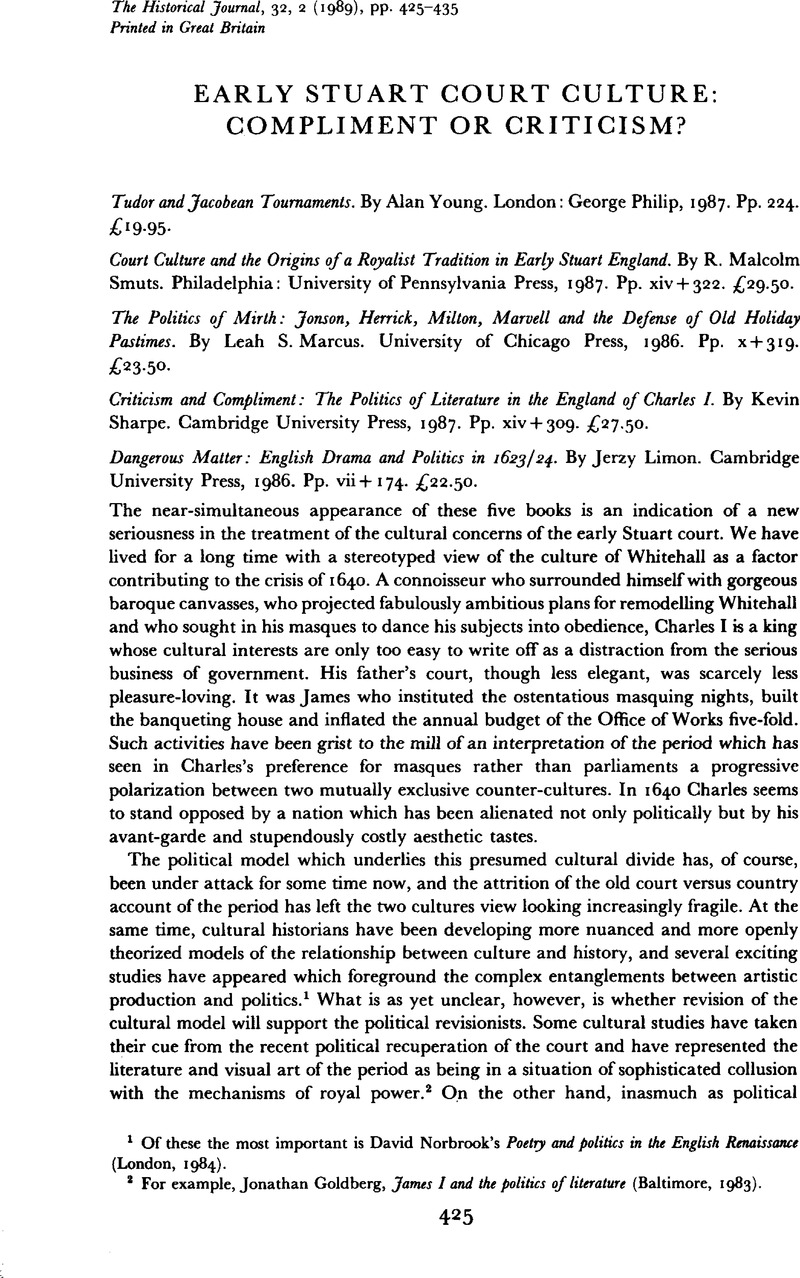Published online by Cambridge University Press: 11 February 2009

1 Of these the most important is Norbrook's, DavidPoetry and politics in the English Renaissance (London, 1984)Google Scholar.
2 For example, Goldberg, Jonathan, James I and the politics of literature (Baltimore, 1983)Google Scholar.
3 For 1624, see Jerzy Limon's Dangerous matter (reviewed below). For 1636, see my ‘Entertaining the Palatine Prince: plays on foreign affairs 1635–1637’ English Literary Renaissance, XIII (1983), 318–44Google Scholar; reprinted in A. Kinney (ed.), Renaissance historicism (1988).
4 Hyde, E., History of the rebellion (ed. Macray, W. D., 6 vols., Oxford, 1888), IV, 490Google Scholar. See also Sharpe, K., ‘The image of virtue: the court and household of Charles I’ in Starkey, D. (ed.), The English Court (London, 1987)Google Scholar.
5 Barton, A., Ben Jonson, dramatist (Cambridge, 1984)CrossRefGoogle Scholar.
6 For a corrective view, see Creaser, J., ‘”The present aid of this occasion”: the setting of Comus’ in Lindley, D. (ed.), The court masque (Manchester, 1984), pp. 111–34Google Scholar.
7 Sharpe quotes the well-known verses in which Carew rebukes the Caroline audiences for not being ‘serious’ enough (p. 151) without recognizing that they formed part of an inter-theatrical rivalry in which the lines were not drawn between ‘good’ drama and ‘bad’ audiences, but between Carew, Davenant and their friends and audiences which, for perfectly respectable reasons, preferred a different (less courtly) drama. Carew may claim that only he and his friends value ‘virtue and wit’ in an ‘adulterate’ age but I doubt whether the audience at the rival playhouse would have agreed. See Gurr's, Andrew essay on this exchange of insults in Neill, Michael (ed.), John Ford: critical revisions (Cambridge, 1988)Google Scholar.
8 For a discussion of this masque which emphasizes the difficulties Davenant had in arguing the counsel of moderation, see my ‘Politics and the masque: Salmacida spolia’ in J. Sawday and T. Healy (eds.), War is all the world about (forthcoming).
9 I argue this case more fully in ‘Politics and the masque: The triumph of peace’, The Seventeenth Century, II, 2 (1987), 117–41Google Scholar.
10 As I have already argued in Theatre and crisis 1632–1642 (Cambridge, 1984), pp. 55–9Google Scholar.
11 Spencer, T. J. B. and Wells, S. (eds.), A book of masques (Cambridge, 1967), p. 358Google Scholar (my emphasis).
12 Ibid. p. 361.
13 In passing, it should be added that Sharpe's argument (p. 16) that because several courtiers wrote ‘country house’ poems they can be said to have voiced politically ‘country’ views within the court, needs serious qualification. Country house poems offered some scope for limited criticism of courtly values but on the whole their social and political imperatives were aristocratic, nostalgic and traditionalist, as literary critics have always emphasized (see Williams, R., The country and the city, 2nd edn, 1975Google Scholar; and Turner, J., The politics of landscape, 1979)Google Scholar. Some plays used country settings to criticize courtly assumptions, but these were very different in kind from country house poems: see my Theatre and crisis, pp. 251–79.
14 The sole exceptions are two plays by Thomas Killigrew performed at the Drury Lane Phoenix.
15 See Gurr's essay cited in note 7 above.
16 Gildersleeve, V., Government regulation of the Elizabethan Drama (New York, 1908), p. 82Google Scholar.
17 For documentation, see my Theatre and crisis, pp. 135–6.
18 See, for example, Dollimore, J., Radical tragedy (Brighton, 1984)Google Scholar.